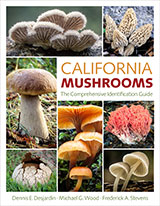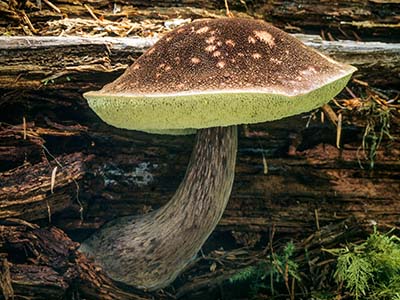A Look at Fungal Distribution Across Latitudes
Within the natural world, one of the most interesting biogeographic patterns of species diversity is that of the latitudinal diversity gradient (LDG). The LDG observes that for most taxa, species richness increases as you move toward, and is greatest at the equator. This global biogeographic pattern has been observed for most taxonomic groups, including terrestrial and marine groups, ectothermic and endothermic taxa, as well as passive or active dispersers (Mittelbach et al., 2007). Despite the strength of this pattern, there is not a universally accepted explanation. Although there are many ecological, evolutionary and historical hypotheses, many agree and regard the tropics as a cradle and a museum, where many taxa originate and persist (Mittelbach et al., 2007).
One taxonomic group that appears to be an exception to the latitudinal diversity gradient pattern are Ectomycrrhizal (ECM) fungi. In a recent study by Tedersoo and colleagues (2012), they performed a meta-analysis using data from 69 study systems and over 6,000 fungal species in order to understand the diversity and community composition of ECM globally. They found higher diversity of ECM in temperate ecosystems, as compared to tropical ecosystems. In addition, they found that host plant families had the strongest effect on the phylogenetic (i.e. diversity) community composition of fungi. They also found that both temperature and precipitation influence fungal richness in temperate and boreal forest biomes. Tedersoo et al. (2012) suggest one possible difference between tropical and temperate environments is soil heterogeneity, with temperate soils having more vertical heterogeneity, as compared to tropical soils. A recent Molecular Ecology Perspective on the Tedersoo et al. (2012) article by Kennedy and colleagues (2012) points to a number of ECM lineages that are ancestrally tropical, but have diversified in the temperate regions, including Clavulina, Amanita, Boletaceae, Russulaceae, Inocybaceae, Cantharellus and Scleroderma.
Does this reversed LDG observation apply to all fungal guilds? This question remains unanswered. In fact, it appears that this may vary across different fungal guilds. For example, Arnold and Lutzoni (2007) sampled endophytic fungi across six locations ranging from the Canadian arctic to the lowland tropical forest of Panama and found that endophyte diversity increased from the northern boreal forests to the tropics, following the classic LDG. There are a number of examples of saprotrophic fungi that have the greatest diversity in the tropics. Examples include the genera Crinipellis, Marasmius, and Mycena, where the greatest species diversity occurs in the tropics.
However, an indoor air fungal study by Amend and colleagues (2010), found fungal diversity of indoor environments was significantly higher in the temperate zones than in the tropics. Following that trend, preliminary results from an unpublished study of combined soil fungi and leaf litter fungi, collected along a latitudinal gradient, found the temperate locations had higher species richness as compared to boreal and tropical regions (Kerekes and Goodheart, unpublished). A study by Lodge and colleagues (1995) compiled a survey and observations of 26 mycologists and created a table summarizing responses of the survey, including fungal species diversity correlating with latitude. In general, they found overall diversity was highest in the tropics. However there were exceptions as, for example, the family Cortinariaceae had greater diversity at middle to high latitudes. In addition, they found there was no apparent variation in diversity with latitude with certain other groups, including the Gasteromycetes. As suggested by Tedersoo et al. (2012), these contrasting biogeographic patterns may be due to the fact that different processes, including at the local and global scale, may be responsible for driving the biodiversity of different fungal guilds.
Compared with macro-organisms, soil micro-organisms are poorly understood with respect to biogeographical patterns. To better understand fungal biogeography, continued global taxonomic studies and inventories are needed, along with phylogenetic and systematic studies. This article was not intended to be a complete summary of fungal biogeography. Instead, its purpose was to highlight the recent work by Tedersoo et al. (2012) which makes an important contribution to our understanding of the global patterns of ECM fungi and discusses possible processes responsible for these patterns.
Literature Cited:
- Amend, A. S., Seifert, K. A., Samson, R., & Bruns, T. D. (2010). Indoor fungal composition is geographically patterned and more diverse in temperate zones than in the tropics. Proceedings of the National Academy of Sciences of the United States of America 107(31): 13748–53. doi:10.1073/pnas.1000454107. (PDF)
- Arnold, A. E., Lutzoni, F. (2007). Diversity and host range of foliar fungal endophytes: are tropical leaves biodiversity hotspots? Ecology 88(3): 541–549. (PDF)
- Kennedy, P. G., Matheny, P. B., Ryberg, K. M., Henkel, T. W., Uehling, J. K., & Smith, M. E. (2012). Scaling up: examining the macroecology of ectomycorrhizal fungi. Molecular ecology 21(17): 4151–4. doi:10.1111/j.1365-294X.2012.05703.x. (PDF)
- Lodge, D. J., Chapela, I., Samuels, G., Uecker, F. A., Desjardin, D., Horak, E., Kirk, P. M., et al. (1995). A Survey of Patterns of Diversity in Non-Lichenized Fungi. Mitt. Eidgenoss. Forsch.anst. Wald Schnee Landsch. 70(1): 157–173. doi:10.1111/j.1461-0248.2007.01020.x. (PDF)
- Mittelbach, G. G., Schemske, D. W., Cornell, H. V., Allen, A. P., Brown, J. M., Bush, M. B., Harrison, S. P., et al. (2007). Evolution and the latitudinal diversity gradient: speciation, extinction and biogeography. Ecology letters 10(4): 315–331. (PDF)
- Tedersoo, L., Bahram, M., Toots, M., Diédhiou, A. G., Henkel, T. W., Kjøller, R., Morris, M. H., et al. (2012). Towards global patterns in the diversity and community structure of ectomycorrhizal fungi. Molecular ecology 21(17), 4160– 4170. doi:10.1111/j.1365-294X.2012.05602.x. (PDF)
About the Author:
Jennifer Kerekes received a Ph.D. in Microbiology in December, 2011 from the University of California at Berkeley, where she worked with Dr.Tom Bruns. She is interested in the ecology and diversity of saprotrophic fungal communities.


